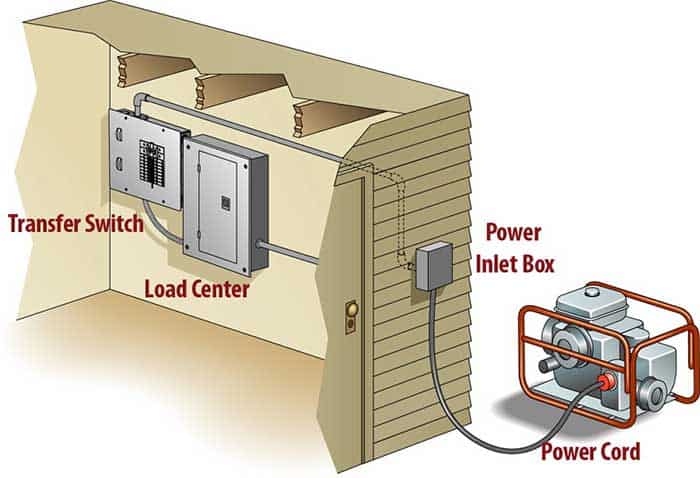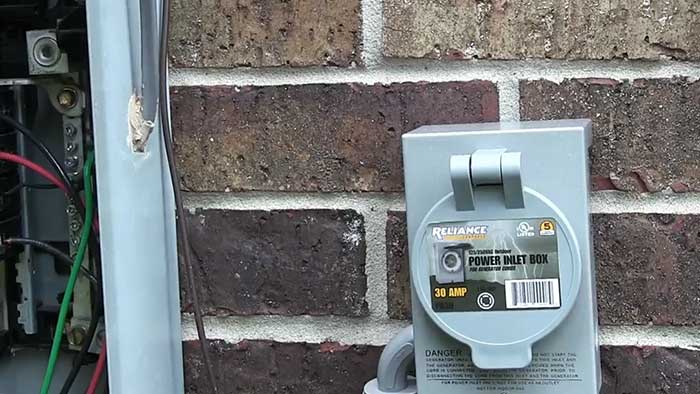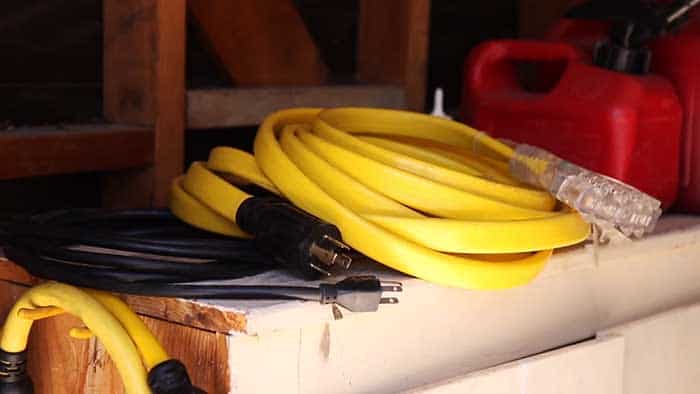Last Updated on September 26, 2023 by mfttherese

Installing a transfer switch to your home allows you to easily and safely switch incoming power from your main electrical panel to a portable generator in the event of a black out/power outage.
Transfer switches come in two configurations, manual and automatic, and both have their pros and cons.
Once you have your switch, you can decide to have it professional installed or tackle the simple process yourself. In this article, I will walk you through the process of wiring a transfer switch to your home and guide you to my top part picks.
Parts Needed to Wire a Transfer Switch
In order to get your transfer switch properly installed, you are going to need some parts.
You can buy a comprehensive kit that includes everything you need, or you can piece them together yourself.
We will look at all of your options to save you the time researching on your own.
Portable Generator
Obviously you are going to need a decent sized portable generator.
Lucky for you, I have broken down the top portable generators available in an easy-to-use buyer’s guide. You can check that out here – https://generatorgrid.com/
Individual Transfer Switch

If you want to order just a switch, you can order a manual or automatic transfer switch individually. Here are a couple of my suggestions:
- Maximum running generator watts: 7,500
- cUL1008 listed
- 5-year product warranty
- Maximum running generator watts: 7,500
- Outdoor capable
- 1-year warranty
Power Inlet Box

The power inlet box mounts on the outside of your house on the other side of the wall of your indoor transfer switch.
It allows you to easily plug in a power cord to connect to your generator. Here are a couple of inlet boxes I found to be great picks.
- 30 Amp
- 125/250 volts
- Up to 7,500 running watts
- 50 amp
- 125/250 volts
- Up to 12,500 running watts
Generator Power Cord

To connect the generator to the transfer switch, you are going to need a power cord. A 20-foot cord is standard and usually plenty to make the connection.
- 30 amp
- 20 foot
- Up to 7,500 running watts
- 50 amp
- 20 foot
- Up to 12,500 running watts
If you’re also considering connecting specific appliances like a hot water heater to your generator, learn how to safely hook up a hot water heater here.
Transfer Switch Installation Process
Wiring a transfer switch to your home can be a daunting process, but with a little bit of electrical knowledge and an attention to detail of the process, you can have the job done in a few hours.
If you do not feel comfortable working with your home’s main electrical panel, please seek professional help.
Since you will be working with your home’s main electrical supply, we highly recommend reviewing your local and state laws and code requirements before tackling this install to prevent any broken laws or code violations.
Disclaimer
This is a general guideline and we assume no liability for property damage or injury incurred as a result of any of the information contained in this article.
Have a look at the video above from This Old House
- First, figure out where you would like the switch to be mounted. You will want this near your panel box for easy installation.
- Once you figure out a safe place for your switch, away from an obstructions, you can securely mount your switch to the wall.
- Switch off the main power to your house at the main electrical panel. You can test your appliances to double check that the power is off.
- Locate the wires that are coming from the transfer switch and connect them to the circuits in your panel box that you wish to control.
- Drill a 1 ½” hole through your house wall (from the outside) near the switch. This will be used to feel wires through from the switch to the electrical receptacle.
- If your switch came with an outdoor electrical box, mount this above the hole on the exterior wall.
- Now, connect the electrical cable from the transfer switch to the electrical box, snaking it through the drilled hole.
- Connect the electrical receptacle to the electrical cable in the outdoor box and screw/mount it to the box.
- Before testing your work, make sure that your portable generator is in good working order.
- To test your work, with your main power still off, use the generator power cord to connect the generator to the outdoor electrical receptacle.
- Start your generator and flip the transfer switch (from line to generator). Your connected appliances should now have power.
- Once everything is confirmed to be working properly, turn the transfer switch from generator to line. You can now turn your main power back on. Before you turn your main power back on, ensure all your connections and systems are in sync, especially if you have specific equipment like boilers.
- It is a good idea to seal the hole that you have drilled to prevent bugs, moisture, and dirt from getting in your home.
In Conclusion
Wrapping things up, the install is not as daunting as most may think.
The most important takeaways are to ensure you have a generator capable of powering the appliances you need, ensure you have all of the correct parts that you need, review code regulations, install the parts correctly, and check for proper function when finished.
Installing a transfer switch is not a common task and I want to hear from those who have installed them.
What was the hardest part of your install? Would you install one again?

Scott Krager purchased generatorgrid.com in the summer of 2020 and quickly began to buy every generator under the sun! He currently has over a dozen generators and the number is growing quickly. He lives in Portland, OR near his family and friends.
GeneratorGrid.com is an independent review business. I am not affiliated with any manufacturers and do not accept paid reviews. When you buy through my links, I may earn a commission which helps me purchase more generators for testing. - Scott Krager


I live inside the city limits. Can I legally install a 30 amp Inlet box that is hardwired to a circuit breaker in my main home circuit panel without having to use an electrician.?
Tim, if your not sure, hire a pro, and most if not all jurisdictions don’t allow this unless there in an interlocking safety device to prevent you from backfeeding power into the grid, because either this will kill a linesman working to restore the power or burn your house down when the do restore the power which normally results in your generator catching on fire. And when your insurance finds out you have done this don’t expect them to be very forthcoming with a payment.
Really it’s not that expensive to have it done by a pro that knows the rules and regulations and can pull a permit and have it done right.
Tim,
That will depend a lot on your municipality. Here in Kansas City, Missouri, a home owner can perform electrical repairs and upgrades without the help of an electrician as long as they’re going to do the work themselves and obtain the proper building permits.
Any other municipality may well have different rules. For safety’s sake, many will require the work to be done by a licensed professional. If the city you live in has a local codes administration, talk to them about the specifics there. If the city has no specific codes or requirements in place for electrical upgrades of this sort, check with the county.